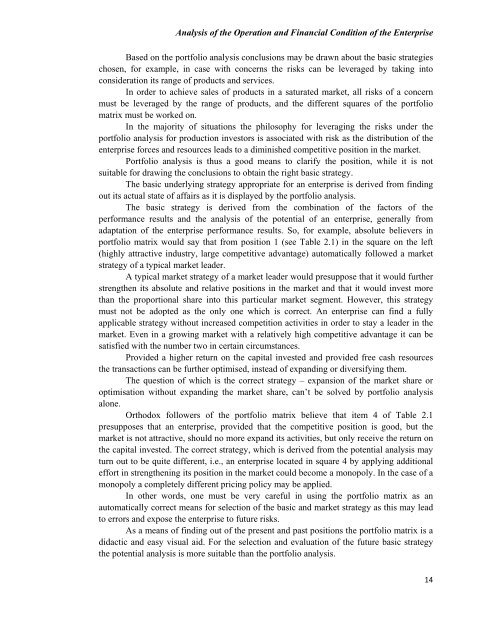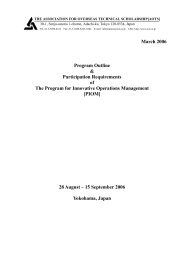Analysis of the Operation and Financial Condition of the Enterprise
Analysis of the Operation and Financial Condition of the Enterprise
Analysis of the Operation and Financial Condition of the Enterprise
Create successful ePaper yourself
Turn your PDF publications into a flip-book with our unique Google optimized e-Paper software.
<strong>Analysis</strong> <strong>of</strong> <strong>the</strong> <strong>Operation</strong> <strong>and</strong> <strong>Financial</strong> <strong>Condition</strong> <strong>of</strong> <strong>the</strong> <strong>Enterprise</strong>Based on <strong>the</strong> portfolio analysis conclusions may be drawn about <strong>the</strong> basic strategieschosen, for example, in case with concerns <strong>the</strong> risks can be leveraged by taking intoconsideration its range <strong>of</strong> products <strong>and</strong> services.In order to achieve sales <strong>of</strong> products in a saturated market, all risks <strong>of</strong> a concernmust be leveraged by <strong>the</strong> range <strong>of</strong> products, <strong>and</strong> <strong>the</strong> different squares <strong>of</strong> <strong>the</strong> portfoliomatrix must be worked on.In <strong>the</strong> majority <strong>of</strong> situations <strong>the</strong> philosophy for leveraging <strong>the</strong> risks under <strong>the</strong>portfolio analysis for production investors is associated with risk as <strong>the</strong> distribution <strong>of</strong> <strong>the</strong>enterprise forces <strong>and</strong> resources leads to a diminished competitive position in <strong>the</strong> market.Portfolio analysis is thus a good means to clarify <strong>the</strong> position, while it is notsuitable for drawing <strong>the</strong> conclusions to obtain <strong>the</strong> right basic strategy.The basic underlying strategy appropriate for an enterprise is derived from findingout its actual state <strong>of</strong> affairs as it is displayed by <strong>the</strong> portfolio analysis.The basic strategy is derived from <strong>the</strong> combination <strong>of</strong> <strong>the</strong> factors <strong>of</strong> <strong>the</strong>performance results <strong>and</strong> <strong>the</strong> analysis <strong>of</strong> <strong>the</strong> potential <strong>of</strong> an enterprise, generally fromadaptation <strong>of</strong> <strong>the</strong> enterprise performance results. So, for example, absolute believers inportfolio matrix would say that from position 1 (see Table 2.1) in <strong>the</strong> square on <strong>the</strong> left(highly attractive industry, large competitive advantage) automatically followed a marketstrategy <strong>of</strong> a typical market leader.A typical market strategy <strong>of</strong> a market leader would presuppose that it would fur<strong>the</strong>rstreng<strong>the</strong>n its absolute <strong>and</strong> relative positions in <strong>the</strong> market <strong>and</strong> that it would invest morethan <strong>the</strong> proportional share into this particular market segment. However, this strategymust not be adopted as <strong>the</strong> only one which is correct. An enterprise can find a fullyapplicable strategy without increased competition activities in order to stay a leader in <strong>the</strong>market. Even in a growing market with a relatively high competitive advantage it can besatisfied with <strong>the</strong> number two in certain circumstances.Provided a higher return on <strong>the</strong> capital invested <strong>and</strong> provided free cash resources<strong>the</strong> transactions can be fur<strong>the</strong>r optimised, instead <strong>of</strong> exp<strong>and</strong>ing or diversifying <strong>the</strong>m.The question <strong>of</strong> which is <strong>the</strong> correct strategy – expansion <strong>of</strong> <strong>the</strong> market share oroptimisation without exp<strong>and</strong>ing <strong>the</strong> market share, can’t be solved by portfolio analysisalone.Orthodox followers <strong>of</strong> <strong>the</strong> portfolio matrix believe that item 4 <strong>of</strong> Table 2.1presupposes that an enterprise, provided that <strong>the</strong> competitive position is good, but <strong>the</strong>market is not attractive, should no more exp<strong>and</strong> its activities, but only receive <strong>the</strong> return on<strong>the</strong> capital invested. The correct strategy, which is derived from <strong>the</strong> potential analysis mayturn out to be quite different, i.e., an enterprise located in square 4 by applying additionaleffort in streng<strong>the</strong>ning its position in <strong>the</strong> market could become a monopoly. In <strong>the</strong> case <strong>of</strong> amonopoly a completely different pricing policy may be applied.In o<strong>the</strong>r words, one must be very careful in using <strong>the</strong> portfolio matrix as anautomatically correct means for selection <strong>of</strong> <strong>the</strong> basic <strong>and</strong> market strategy as this may leadto errors <strong>and</strong> expose <strong>the</strong> enterprise to future risks.As a means <strong>of</strong> finding out <strong>of</strong> <strong>the</strong> present <strong>and</strong> past positions <strong>the</strong> portfolio matrix is adidactic <strong>and</strong> easy visual aid. For <strong>the</strong> selection <strong>and</strong> evaluation <strong>of</strong> <strong>the</strong> future basic strategy<strong>the</strong> potential analysis is more suitable than <strong>the</strong> portfolio analysis.14
















